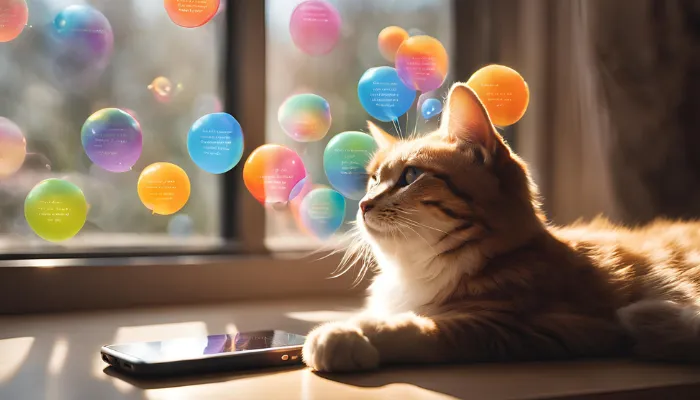How Do Cats Say “I Hate You”? While cats are enigmatic and self-reliant animals, they make it quite distinct when they are annoyed or uncomfortable. Signs like swatting, hissing, growling, to more discreet signs like avoiding you, tail flicking, or flattened ears; all these actions from cats signify their discontent. Using a cat translator can help decode these behaviors, giving you better insight into their emotions.
Knowing what each signal represents is important to have a good relationship with your cat. Once you listen to what your cat is trying to say, you can cater to their needs and heal your relationship with them.

Signs Your Cat Might Be Saying “I Hate You”
How do cats say “I hate you”? Cats have subtle yet clear ways of showing their displeasure. Here are some signs to watch for when your feline isn’t too happy with you.
1. The Classic Hiss or Growl
Cats with vocalization problems have a very strong hissing noise or growl that is meant to express their dislike towards something. A hiss or growl is not positive as there seems to be threat, annoyance or discomfort attached to these sounds. If your cat hisses at you, it is effectively trying to say, “Get away!”.
2. Avoidance Behavior
People often wonder what do stray cats do all day? They avoid people. The fact that they rely on avoidance behavior shows how non-social and independent cats are. Avoiding you by not being in the room with you or turning their back towards you is also another behavior that shows disliking. Withdrawal is a loose aggressive method cats use to show their discontent.
3. The Tail Flick
Tail of a cat is a tool to convey feelings and emotions. If the cat is slow giving out a flick or the tail is curled, that indicates irritation or anger. If the said tail is twitching rapidly and the cat is staring at you, then that means he is very angry.
4. Flat Ears and Dilated Pupils
When the cat shows pupils that are dilated, followed by ears that are flat against the head then that might imply aggression or fear. History has shown that the above body language frequently accompanies other forms of dislike attached like hissing and growling.
5. Swatting and Scratching
Scratch or swat motions without provocation show displeasure from the cat. Even though cat playfully swats, some cats exhibit overly aggressive swatting which signals, “I hate you.”
Understanding these signals can help you respond appropriately, easing tension and rebuilding a stronger bond with your feline friend.
Why Do Cats Express Dislike?
Understanding How Do Cats Say “I Hate You”? is only half the battle. It’s equally important to know why they feel this way. Here are some common reasons:
- Overstimulation: Cats often display aggression after prolonged interaction, like excess petting or playtime.
- Territorial Behavior: Cats tend to be protective of their personal space and can get violent if it is crossed.
- Fear or Stress: Stressful situations like relocation, new pets, or strangers can easily trigger a negative response from cats.
- Health Issues: Withdrawal and aggression are common signs in cats that suffer from untreated health problems.
By identifying the cause of their discomfort, you can help improve your cat’s mood and strengthen your bond.
How to Respond to a Cat’s Dislike?
If your cat is showing signs of dislike, it’s important to respond appropriately. Here are some tips:
- Give Them Space: Never touch the cat without their permission and don’t try forcing them to interact with you.
- Identify Triggers: Try to notice what exactly makes them behave so negatively and do what you can to minimize or get rid of it entirely.
- Motivate the Pet through Positive Reinforcement: Show affection and give treats to build trust in your pet.
- Seek the Advice of a Vet: Sudden or extreme behavior can be a cause for concern and should be checked by a professional.
You can manage unwanted conduct and negative behaviors and turn them into positive connections by building boundaries and dealing with issues at the root level.
Signs of Dislike vs. Affection in Cats
Understanding How Do Cats Say “I Hate You”? versus how they show affection can help you better interpret your cat’s behavior. Here’s a quick comparison to guide you.
| Behavior | Dislike | Affection |
|---|---|---|
| Tail Movement | Rapid flicking or puffed-up tail | Slow, gentle swaying |
| Vocalizations | Hissing, growling | Soft meowing, purring |
| Eye Contact | Staring with dilated pupils | Slow blinking |
| Body Posture | Arched back, flattened ears | Relaxed, lying on back |
| Interaction | Avoidance, swatting | Rubbing against you, kneading |
Recognizing these differences will strengthen your bond and ensure you respond to your cat’s needs appropriately.
Conclusion
How Do Cats Say “I Hate You”? Cats display hate in their actions through hissing, growls, and provoked aggression such as tail flicks, swatting, or avoidant behaviors. Understanding these signals can help understand when a cat is stressed, agitated, or even feels threatened.
Identifying the source of discomfort and responding caringly can allow them to trust you more deeply, in turn, strengthening the bond between you two.
